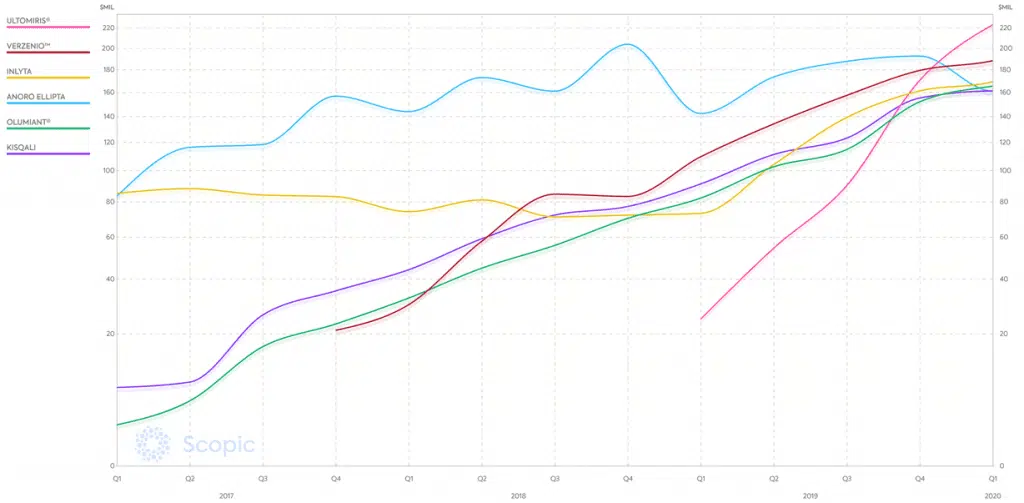Table of Contents
Since opening our virtual doors in 2006, the Scopic team has always been driven by innovation and growth across multiple industries.
And that’s not just a bunch of buzz words — we began as a software development firm and have now grown into a full-service, multi-tiered software development-digital marketing-design agency. Over the past decade, we have proven ourselves as the go-to company for affordable and reliable healthcare software development and biotech software solutions. And we aren’t stopping there. Allow us to introduce our latest Scopic project, Biotecharts: the new home for unique drug revenue charts for biotech traders, analysts, enthusiasts, and more. So what inspired us to use our expertise in this field?
Welcome to a One-of-a-Kind Biotech Resource: Biotecharts
Because of extensive testing and research over the past few decades, biopharma trends and data have become more consistent and reliable. This has created an industry-wide need for tools that can aid in industry planning and biotech investing. At Scopic, we have watched the exponential growth of the industry and have closely monitored the robust data released. However, we noticed that there wasn’t a place to properly view and analyze this highly-useful biotech information. And this is where the Scopic development team hatched up the idea for Biotecharts.
Biotecharts is the home of detailed drug revenue charts for biotech traders, analysts, advisors, content producers, and enthusiasts. On the Biotecharts website, users will find unique drug revenue biotech charts that are useful for guiding product planning, revenue forecasting, financial biopharma analytics, market commentary, and biotechnology investing. Our versatile charts, and the data within, are not available elsewhere. Here is an example of one of our charts for the Fastest Growing Drugs:

Fastest Growing Drugs – Revenue Class from 150M to 200M
An Intro to Biotechnology
For those new to the Biotechnology field, here’s a little introduction. This broad field encompasses all practical uses of living organisms to develop products that are designed to improve humans’ lives. Novel techniques are used to modify genetic information in organisms and microorganisms in order to either produce complex products or to amplify their natural characteristics for commercial use. This science is currently used to create new fuels, to clean the environment, to bring more stability to global food production, and much more. Which brings us to one of the fastest-growing subsets of this field: the application of biotechnology to produce innovative drugs.
Biotech drugs are very complex active compounds that use the natural assembly line of microorganisms to synthesize proteins that could not be produced by regular chemical pathways. A common example is insulin, a biotech drug that millions of Americans could not live without. Up until the early 2000s, insulin had to be extracted from animals, which caused varying negative side effects and was expensive to extract. Because of the use of biotechnology, human insulin is now created safely in labs from microorganisms that don’t cause the same negative side effects. It’s easier, safer, and more efficient.
Biopharmaceutical drugs (like insulin) are currently treating previously untreatable or rare conditions and diseases in areas such as oncology, endocrinology, cardiology, neurology, and more. It is also important to note that the spotlight is currently on biotechnology as a front runner in the development of vaccines for preventing diseases, including COVID-19. With the vast treatment and prevention capabilities of these drugs, the biotechnology industry can boast these achievements:
- Reducing rates of infectious disease (for example, vaccines)
- Reducing death rates by life-threatening conditions (for example, therapeutic antibodies for treating cancer)
- Minimizing health risks and side effects (for example, human growth hormones)
- Providing more accurate tools for detection (for example, PCR detection)
And these are just a few of the vast achievements of the biotech industry that add up to millions of lives saved every year!
The Past and Present of the Biotech Industry
Biotech drugs have technically been around since penicillin was discovered by chance in Fleming’s lab in the 1920s. Since then, through the discovery of DNA, the understanding of the transcription process, and discovering how to manipulate it, we reached the era in which biotech drugs went from the labs to consumers’ medicine cabinets.
Although biotech firms and massed-produced biotech drugs have only existed since the 1980s, because these drugs have offered innovative ways to treat diseases, the growth and use of these treatments have been gaining massive relevancy inside the global pharmaceutical market. In fact, over 25% of all pharmaceuticals currently on the market are biopharmaceuticals.
This huge presence in the market is thanks to the great revenue, investment, and research dollars pumped into the industry. In 2017, the over 830 dedicated biotechnology companies that existed in the US alone spent around 45 billion dollars in biotech market research and development in the biotech sector. In comparison, Germany spent just under 1.5 billion dollars that same year.
This substantial investment is translating directly into more revenue for the industry. For example, the top 10 global biotech drug producers made 175.3 billion dollars in 2019 by selling biotech prescription drugs. And it is projected that these companies will bring in around 260 billion dollars during the year 2026.
While growth is consistent and billions and billions of dollars are continually invested into the industry every year, regulation forces the sector in the US to make only incremental growth. Biotech companies are now driven to create more effective manufacturing production so they can produce more drugs more quickly. Biosimilar companies have also become very competitive in the market, producing already existing biotech drugs with the known formula for generic medicines. This drives sales, saves the consumer money, and gives them more options.
A Unique Look at the Biotech Market
The amount of biopharmaceutical statistics and market data is immense, but there isn’t a place for biotech professionals to effectively view and analyze such market information like biosimilars, fastest-growing drugs, and so on. That is…until now. Biotecharts users can visualize brand name drugs in various revenue contexts using our easy-to-read charts. Once logged in, users gain full, immediate access to all of our data and can view these charts by specific categories or factors, select the chart size, and even download as images for later use. The biotech charts housed on the site include:
- Fastest growing drugs
- Fastest declining drugs
- Cumulative drug revenues by company
- Cumulative drug revenues by class
- Hot drugs
- Major biopharma drugs
- Specialty Drug Market
Our model is currently free of cost and all of our users will gain full access to all of these handy biopharma analytics charts. The chart variables are customizable to ensure that you are accessing the most relevant information to best serve your biotech market research needs. Our quarterly updates of the graphs provide continually pertinent and useful biotech information, and users are free to download our data for use in presentations, in studies, or with clients. The data that our biotech charts present help industry pros make biotech investment decisions today and plan and forecast for the future, with concrete data to support their decisions.
The Future of Biotech
The biotech industry has been growing at a rapid pace since the 80s and has shown no signs of slowing down, even during a global pandemic. While many industries have been driven to a standstill due to the threat of COVID-19, biotech is not one such industry. In fact, during the peak of the pandemic, investment in private biotech drugs reached an all-time high. Funding into US-based biopharma companies reached over 6.4 billion dollars in one quarter – the largest quarter in the history of the industry. This rush to invest in biotech stocks could very well be explained by the public’s hope that biotech could be the solution to this global pandemic, but whatever the reason for the bump, we can assume that this will lead to even more innovative drugs on the market in the coming years.
But how quickly will we see these drugs on the shelves? It’s hard to tell as developing new biotech drugs is costly and time-consuming. Although innovation is consistent, it isn’t as visible as with other industries due to extensive testing and strict drug regulation that every American biotech company must adhere to. This regulation makes for slower growth, but because it is more consistent, the growth is easier to chart over time, making data key to forecasting trends, product planning, and investing.
This is the exact data that you can now view for free on Biotecharts. While much of the future of biotechnology is open to speculation, one thing is for sure: the growth of biotech will not be slowing anytime soon. This means more innovation, more jobs, more investment, and many more lives saved. Check out how our biotech charts will provide you with key industry perspectives and a competitive edge.





